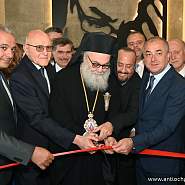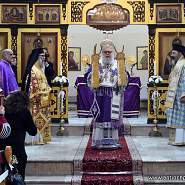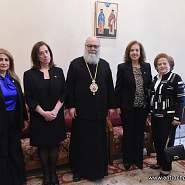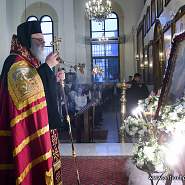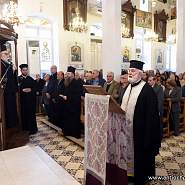St. Nektarios the Wonderworker, Bishop of…
St. Nectarius, the great wonder-worker of modern times, commemorated on November 9, was born Anastasius Kephalas in Selebria, Thrace on October 1, 1846.
Since his family was poor, Anastasius went to Constantinople when he was 14 in order to find work. Although he had no money, he asked the captain of a boat to take him. The captain told him to take a walk & then come back. Anastasius understood, & sadly walked away.
The captain gave the order to start the engines, but nothing happened. After several unsuccessful attempts, he looked up into the eyes of Anastasius who stood on the dock. Taking pity on the boy, the captain told him to come aboard. Immediately, the engines started & the boat began to move.
Anastasius found a job with a tobacco merchant in Constantinople, who did not pay him very much. In his desire to share useful information with others, Anastasius wrote down short maxims from spiritual books on the paper bags & packages of the tobacco shop. The customers would read them out of curiosity & might perhaps derive some benefit from them.
The boy went about barefoot & in ragged clothing, but he trusted in God. Seeing that the merchant received many letters, Anastasius also wanted to write a letter. To whom could he write? Not to his parents, because there were no mail deliveries to his village. Not to his friends, because he had none. Therefore, he decided to write to Christ to tell Him of his needs.
“My little Christ,” he wrote. “I do not have an apron or shoes. Thou sendest them to me. Thou knowest how much I love Thee.”
Anastasius sealed the letter & wrote on the outside: “To the Lord Jesus Christ in Heaven.” On his way to mail the letter, he ran into the man who owned a shop opposite the one in which he worked. The man ask-ed him where he was going, & Anastasius whispered something in reply. Seeing the letter in his hands, the man offered to mail it for him, since he was on his way to the post office.
The merchant put the letter in his pocket & assured Anastasius that he would mail it with his own letters. The boy returned to the tobacco shop, filled with happiness. When he took the letter from his pocket to mail it, the merchant happened to notice the address. Astonished & curious, the man could not resist opening the letter to read it. Touched by the boy’s simple faith, the merchant placed some money in an envelope & sent it to him anonymously. Anastasius was filled with joy, & he gave thanks to God.
A few days later, seeing Anastasius dressed somewhat better than usual, his employer thought he had stolen money from him & began to beat him. Anastasius cried out, “I have never stolen anything. My little Christ sent me the money.”
Hearing the commotion, the other merchant came & took the tobacco seller aside & explained the situation to him.
When he was still a young man, Anastasius made a pilgrimage to the Holy Land. During the voyage, the ship was in danger of sinking in a storm. Anastasius looked at the raging sea, & then at the captain. He went & stood beside the captain & took the helm, praying for God to save them. Then he took off the cross his grandmother had given him (containing a piece of the Cross of Christ) & tied it to his belt. Leaning over the side, he dipped the cross into the water 3 times & commanded the sea, “Silence! Be still.” At once, the wind died down & the sea became calm.
Anastasius was saddened, however, because his cross had fallen into the sea & was lost. As the boat sail-ed on, sounds of knocking seemed to come from the hull below the water line. When the ship docked, the young man got off and started to walk away. Suddenly, the captain began shouting, “Kephalas, Kephalas, come back here.” The captain had ordered some men into a small boat to examine the hull in order to dis-cover the source of the knocking, & they discovered the cross stuck to the hull. Anastasius was elated to receive his “Treasure,” & always wore it from that time forward. There is a photograph taken many years later, showing the saint in his monastic skufia. The cross is clearly visible in the photo.
On Nov. 7, 1875, Anastasius received monastic tonsure at the Nea Moni Monastery on Chios, & the new name Lazarus. 2 years later, he was ordained a deacon. On that occasion, his name was changed to Nectarius.
Later, when he was a priest, Fr. Nectarius left Chios & went to Egypt. There he was elected Metropolitan of Pentapolis. Some of his colleagues became jealous of him because of his great virtues, because of his inspiring sermons & because of everything else which distinguished St Nectarius from them.
Other Metropolitans & bishops of the Patriarchate of Alexandria became filled with malice toward the saint, so they told Patriarch Sophronius that Nectarius was plotting to become patriarch himself. They told the patriarch that the Metropolitan of Pentapolis merely made an outward show of piety in order to win favor with the people. So the patriarch & his synod removed St. Nectarius from his See. Patriarch Sophronius wrote an ambiguous letter of suspension which provoked scandal & speculation about the true reasons for the saint’s removal from his position.
St. Nectarius was not deposed from his rank, however. He was still allowed to function as a bishop. If anyone invited him to perform a wedding or a baptism he could do so, as long as he obtained permission from the local bishop.
St. Nectarius bore his trials with great patience, but those who loved him began to demand to know why he had been removed. Seeing that this was causing a disturbance in the Church of Alexandria, he decided to go to Greece. He arrived in Athens to find that false rumors about him had already reached that city. His letter of suspension said only that he had been removed “for reasons known to the Patriarchate,” & so all the slanders about him were believed.
Since the state & ecclesiastical authorities would not give him a position, the former Metropolitan was left with no means of support & no place to live. Every day he went to the Minister of Religion asking for as-sistance. They soon tired of him and began to mistreat him.
One day, as he was leaving the Minister’s office, St. Nectarius met a friend whom he had known in Egypt. Surprised to find the beloved bishop in such a condition, the man spoke to the Minister of Religion & Education & asked that something be found for him. So, St Nectarius was appointed to be a humble preacher in the diocese of Vitineia & Euboea. The saint did not regard this as humiliating for him, even though a simple monk could have filled that position. He went to Euboea to preach in the churches, eager-ly embracing his duties.
Yet even here, the rumors of scandal followed him. Sometimes, while he was preaching, people began to laugh & whisper. Therefore, the blameless one resigned his position & returned to Athens. By then some people had begun to realize that the rumors were untrue, because they saw nothing in his life or conver-sation to suggest that he was guilty of anything. With their help & influence, St Nectarius was appointed Director of the Rizarios Seminary in Athens on March 8, 1894. He was to remain in that position until Dec. of 1908.
The following story is illustrative of the great love & humility that St. Nektarios bore throughout his life:
“[St. Nektarios] had once again fallen ill & suffered for 15 days. He had headaches, dizzyness & weakness. He liter-ally dragged himself to his lectures [at Rizarios school]. His illness had probably been brought about by the extra work load he had secretly undertaken for the school custodian Loukianos. Loukianos had suddenly fallen ill due to fail-ing kidneys, & having been overcome by excruciating pain 1 day on the job, he had to be taken to the Evangelismos Hospital across the street. He then under-went a dangerous & painful operation & was ordered by his physicians not to return to work for at least 2½ months. Nektarios felt deep pity for the man & decided that he would do the work for him until he was able to come back. So, Nektarios would wake up at dawn & take to cleaning toilets & floors & what-ever work was left undone by the assistant janitors.”
(from The Saint of our Century by Chondropoulos)
The saint celebrated the services in the seminary church, taught the students & wrote several edifying & useful books. Since he was a quiet man, St. Nectarius did not care for the noise & bustle of Athens. He wanted to retire somewhere where he could pray. On the island of Aegina he found an abandoned monastery dedicated to the Holy Trinity, which he began to repair with his own hands.
He gathered a community of nuns, appointing the blind nun Xenia as ab-bess, while he himself served as Father Confessor. Since he had a gift for spiritual direction, many people came to Aegina to confess to him. Eventually, the community grew to 30 nuns. He used to tell them, “I am building a lighthouse for you, & God shall put a light in it that will shine forth to the world. Many will see this light & come to Aegina.” They did not understand what he was telling them, that he himself would be that beacon, & that people would come there to venerate his holy relics.
A photograph of St. Nektarios (I believe) serving at his last (earthly) Divine Liturgy
On Sept. 20, 1920 the nun Euphemia brought an old man in black robes, who was obviously in pain, to the Aretaieion Hospital in Athens. This was a state hospital for the poor. The intern asked the nun for information about the patient.
“Is he a monk?” he asked.
“No, he is a bishop.”
The intern laughed & said, “Stop joking & tell me his name, Mother, so that I can enter it in the register.”
“He is indeed a bishop, my child. He is the Most Reverend Metropolitan of Pentapolis.”
The intern muttered, “For the 1st time in my life I see a bishop without a panagia or cross, & more signi-ficantly, without money.”
Then the nun showed the saint’s credentials to the astonished intern who then admitted him. For 2 months St. Nectarius suffered from a disease of the bladder. At 10:30 on the evening of Nov. 8, 1920, he surrendered his holy soul to God. He died in peace at the age of 74.
In the bed next to St Nectarius was a man who was paralyzed. As soon as the saint had breathed his last, the nurse & the nun who sat with him began to dress him in clean clothing to prepare him for burial at Aegina. They removed his sweater & placed it on the paralyzed man’s bed. Immediately, the paralytic got up from his bed, glorifying God.
The repose of St. Nektarios, showing St. Savvas the New of Kalymnos, who was not the only clergyman to officiate at St. Nectarios’ funeral, but also perceived his great holiness & painted the 1st icon of him, before he was officially proclaimed a Saint.
St. Nectarius was buried at the Holy Trinity Monastery on Aegina. Several years later, his grave was opened to remove his bones (as is the custom in Greece). His body was found whole & incorrupt, as if he had been buried that very day.
Word was sent to the Archbishop of Athens, who came to see the relics for himself. Archbishop Chrysostomos told the nuns to leave them out in the sun for a few days, then to rebury them so that they would decay. A month or 2 after this, they opened the grave again & found the saint incorrupt. Then the relics were placed in a marble sarcophagus.
Several years later, the holy relics dissolved, leaving only the bones.* The saint’s head was placed in a bishop’s mitre, & the top was opened to allow people to kiss his head.
St Nectarius was glorified by God, since his whole life was a continuous doxology to the Lord. Both during his life & after his death, St Nectarius has performed thousands of miracles, especially for those suffering from cancer. There are more churches dedicated to St Nectarius than to any other modern Orthodox saint.”
*The dissolution of St. Nektarios’ relics (just as their previous incorruption) was truly by the will of God. The following story illustrates this: “There was a rich old lady who had met Nektarios at the monastery & he was her confessor several times. She was now living in Piraeus alone, & cried both day & night over the fact that Nektarios’ body had dissolved. She hoped that Nektarios’ body would be eternally intact, like the relic of St. Dionysios on her native island of Zakynthos. She thought that this would be a tribute to Orthodoxy. One night, the old woman saw Nektarios alive at her bedside. He smiled lovingly & sweetly at her. “Why are you so sad?” he asked her. “It was I who prayed to God to allow the decomposition of my body. I did this for all the pious Christians, for whose consolation the relics will now be able to be sent around Greece & around the world.” The old woman awoke a bit shaken, but was nevertheless filled with gratitude at seeing her beloved confessor alive & speaking to her.” (from The Saint of our Century by Chondropoulos)

2024-04-18
2024-04-14
Sunday Liturgy of Saint John…
2024-04-12
His Beatitude Receives a…
2024-04-12
The Fourth Akathist Prayer in…
2024-04-11
Great Compline Prayer in Jdeidat…



